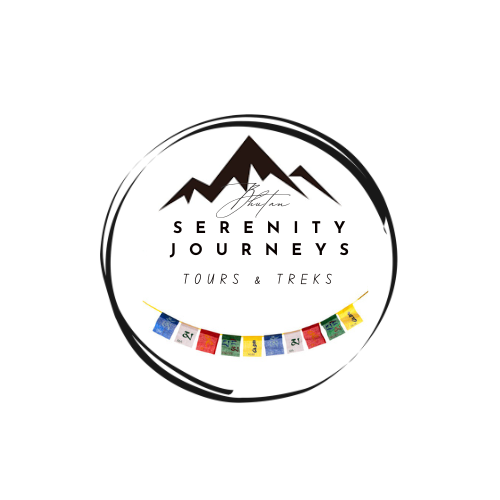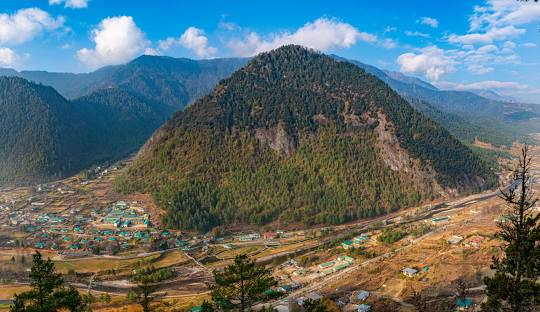



Therefore, experience the essence of Bhutan in our meticulously crafted 7-days Thimphu Tshechu Festival, designed to focuses on Bhutan’s cultural highlights, including iconic monasteries and breathtaking landscapes and experience a spectacle of color, music, and dance unfolding when you join this year’s Thimphu Tshechu in the kingdom of Bhutan.
Price from: US$3004 / Person
Welcome to Bhutan, the Land of the Thunder Dragon. Touching down at Paro International Airport, you will be greeted by your guide upon exiting the arrival hall. Today, we will take it easy to acclimatize to the altitude. Drive to Thimphu, check in to the hotel and let’s have your first taste of Bhutanese cuisine.
Buddha Point at Kuensel Phodrang will also be open to tourists once it is completed. The 169 feet bronze statue of Buddha Dordenma , Vajra Throne Buddha symbolising indestructibility will be completed soon. The Buddha statue itself is competed awaiting paintings, but visitors can drive up to the Buddha point and view the tallest statue of Lord Buddha. The view of Thimphu valley from the Buddha Point is spectacular and beautiful, especially at night. Heritage Museum - Dedicated to connecting people to the Bhutanese rural past though exhibition of artefacts used in rural households. National Memorial Chorten which was built in honor of the late King Jigme Dorji Wangchuk. Centenary Farmers’ Market - Every Saturday and Sunday most of the Thimphu population congregate on the banks of the river where the weekend market is held. Here villagers from the valley and other nearby places come to sell their agriculture products.
The trek to Phajoding Monastery is around 3 hours trek up and around 2 hours trek down. But if there is more time then you can trek all the way up to Thuje Dra till you can see the skull mountain. The view from Phajoding Monastery and Thuje Dra of Thimphu is simply breath taking. From the top of Thuje Dra, you can see the Rhododendron bushes stretching all the way. This trek is part of the Druk Path Trek.
Changangkha Monastery - Built in 12th century, Changangkha Lhakhang is oldest temple in Thimphu. It is hovering over a ridge above Thimphu, near Motithang. Lama Phajo Drukgom Zhigpo who came to Bhutan from Ralung in Tibet chose this site to build this lhakhang. The Lhakhang housed Chenrizig: an 11 headed, thousand-armed manifestation of Avolokitesawara as the central status. Textile Museum- witnesses the art of traditional weaving. Paper making factory- witnesses the art of paper making.
You will travel from the capital to Panukha to visit historical sites and spiritual sanctuaries. Your journey includes a visit to a unique monument constructed over the years to appreciate the arts and architecture of Bhutan. On your way, visit Dochula Pass- The 108 Chortens were built by the present Queen Mother of Bhutan, Ashi Dorji Wangmo Wangchuck to commemorate Bhutan's victory over Indian militants and to liberate the souls of the souls lost.
Exlpore Punakha Dzong-Built in 1637, the dzong continues to be the winter home for the clergy, headed by Chief Abbott, the Je Khenpo. It is a stunning example of Bhutanese architecture, sitting at the fork of two rivers, portraying the image of a medieval city from a distance. Khamsum Yulley Namgyal Chorten-Built by the third Queen Mother Ashi Tshering Yangdon Wangchuck this Chorten is a splendid example of Bhutanese architecture and art and is the only one of its kind in the world. It has been built over eight and a half years, and its details have been drawn from religious scripture.
In the morning, we join the local in their Crane Festival. The valley of Phobjikha is well known as the winter home of the Black necked crane (Grus Nigricollis). Bhutan is home to around six hundred black necked cranes with Phobjikha being one of the popular places that the birds migrate to in the winter months from the Tibetan plateau. The elegant and shy birds can be observed from early November to end of March. Overlooking the Phobjikha valley is the Gangtey Goempa, this is an old monastery that dates back to 17th century. Nature Hike along the valley of Phobjikha Nature Hike along the valley of Phobjikha
Visit Black-Necked Crane Information Centre, which has informative displays about the cranes and the valley environment. You can use the centre’s powerful spotting scopes and check what you see against its pamphlet ’Field Guide to Crane Behaviour’. If the weather’s iffy you can browse the library and handicraft shop, and watch videos at 10am and 3pm (Nu 200). This is also the centre of the valley’s fledgling ecotourism initiative and they can arrange mountain-bike hire (Nu 700 per day), a local guide (Nu 300), an overnight stay in a local farmhouse (Nu 500) or lectures on the local ecosystem
Talo Village - The village of Talo, high on hills above Punakha is located at an altitude 2800m. The village is scattered along the hill slopes. Talo Sangnacholing is built on a plateau with a majestic view of surrounding villages. Chhimi Lhakhang - A 20 minutes’ walk across terraced fields through the village of Sopsokha from the roadside to the small temple located on a hillock in the centre of the valley below Metshina. Ngawang Chogyel built the temple in 15th century after the divine Madman’ Drukpa Kuenlay built a small chorten there. It is a pilgrim site for barren women.
Paro Dzong – also known as Rinpung Dzong, this 15th century massive fortress/monastery is also the administrative center of the Dzongkhag. Ta Dzong - Built as a watch tower the Ta Dzong, it was converted into the National Museum in 1968. The museum boasts antique Thangka, textiles, weapons and armour, household objects and rich assortment of natural and historic artifacts.
Drive to Haa through Chele La (3,988m). From the pass you can see Paro valley on one side and then Haa valley on the other. You can also have a picnic at Chele La if you like to.
In Haa, some sightseeing and then going to katsho village and visiting the Katso Lhakhang. The valley of Haa was only opened to Tourist in 2002 and Haa is the least visited valley in Bhutan due to the lack of Tourist infrastructure. This has helped in keeping Haa the way it has always been, with Bhutanese families living their traditional and simple life. There are no tourist standard hotels in Haa valley so we return back to Paro for the night.
Hike from Sang Choekor Buddhist College (2,800m) to Yak Pasture below Bumdra Monastery (3,800m). The adventure begins with an early morning drive up to the Sang Choekor to meet our ponies and while they are being loaded, we may pay our respects at the College. The initial 1–2-hour ascent of a ridge, which is steep at times though also in cool shade, brings us to a clearing with prayer flags and view down into both the Paro and Do Chhu valleys. Above and ahead the Chhoe Chhoe Tse Lhakhang (temple) nestles in the mountainside 1-2 hours walk away. The trail undulates for a while before the last steep pull up to the pretty temple which boasts commanding views south over Paro airport and from its own hot stone bath northwards to the snow-capped Himalaya. After a final 20 minutes climb through ruins and fluttering prayer flags, with a last glance southward we plunge back into ancient forest traversing for about 40 minutes then come out onto a high wide meadow dotted with sacred chortens and prayer flags. Our home for the night is tucked in under Bumdra Monastery (cave of a thousand prayers) making the most of the awesome views of the Himalayan range.
we can visit the monastery (if it is occupied) and also climb the peak to the north (about 4000m) for even better views, returning in time for a slap-up dinner.
After a hearty breakfast in the jaw dropping landscape, it is time to either head straight back into the valley or linger awhile soaking up the view and perhaps hang some prayer flags of our own. Eventually we have to drop back into the ancient pine and rhododendron forest on the monks’ zig zag trail. After 1-2 hours of descent, we catch glimpses of the golden roofs of temples below and soon come upon the first of many on our way back from the wilds. The path snakes across the mountainside between the monasteries and temples before reaching the gardens of Sangtopelri (Heaven on Earth) from which you can bravely peer over edge and straight down onto the ornate roofs Taktsang in the cliff far below.
Taktsang Monastery is a prominent Himalayan Buddhist sacred site and temple complex located on the cliff side of Paro Valley. According to legends, it is believed that Guru Rinpoche flew to this location from Tibet on the back of a Tigress (his consort Yeshey Tshogyal) and meditated in one of the caves. Guru Rinpoche performed meditation and emerged in eight manifestations and the place became holy. Thus, gaining the name tiger’s nest.
Breakfast in the hotel, then drive to Paro International Airport or the Bhakdora airport for flight to your onward destination. We bid farewell and wish ourselves in the hope to meet again. We hope you cherish this special trip in your life and nourish yourself with all the positive energy accumulated through the journey.
1 Person : US$ 3004/
2 Person : US$ 2337/-per person
3 Person : US$ 2412/-per person
4 Person : US$ 2226/-per person
5 Person : US$ 2157/-per person
6 Person : US$ 2115/-per person
The charges shown may not be all-inclusive and are merely an overview. We can make you a legally binding offer once we have investigated and taken into account all relevent factors. For further enquire please contact us.
• Accommodation on twin sharing/Single room according to traveler number
• Breakfast & dinner at the hotel & lunch at the local restaurants
• All transfers, transportation and sightseeing as per the itinerary
• English speaking accompanying guide
• Governmental royalty and taxes
• Entrances fee
• 2 water bottle per person per day basis on the vehicle
• Luxury hotel upgrades are available at additional cost
• Travel insurance
• Personal expenses such as drinks, postage, and laundry, etc
• Telephone and internet
• Emergency evacuation
• Tips and gratuities
• Costs arising from unforeseen events
• Extra activities like cultural shows, kayaking, etc
• Passport Data Page Scan: Full page but no cropping, and all letters legible, even small one and no flares. Mostly importantly, the Passport need to be valid at least 6 months from the date of entry.
• Portrait Photograph: Passport-size format or selfie with white background.
1. Preparing for your Journeys (Download)
2. Essential Information (Download)